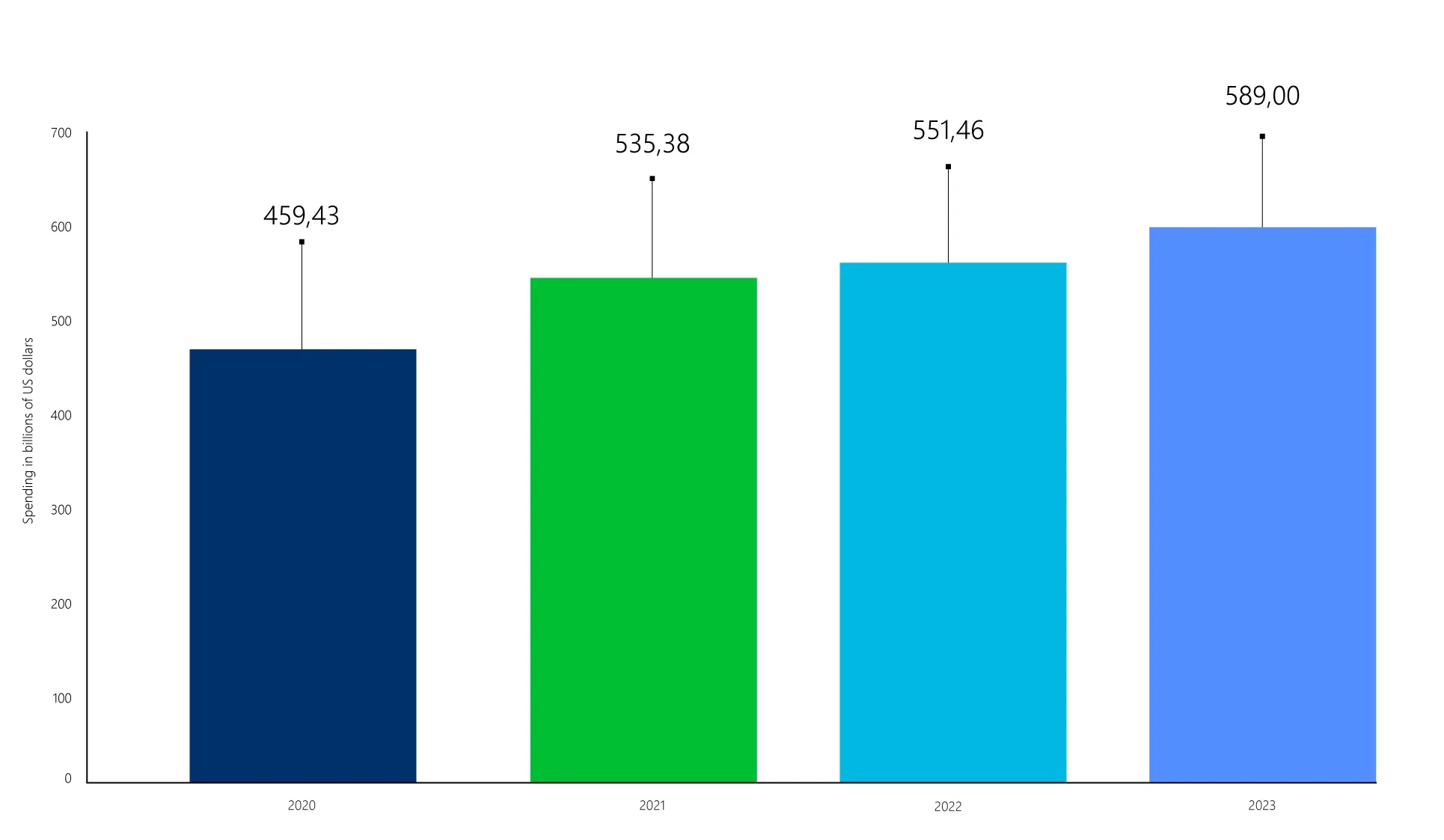- Chapter I: Change Management
- Chapter I.2: The role of the management
- Chapter II: Effective IT cost management
- Chapter II.1: IT costs - an increasing burden
- Chapter II.2: Quick wins and long-term strategies
- Chapter II.3: Tips for reducing IT costs
- Chapter III: How software testing works
- Chapter III.1: Preparing for the test phase
- Chapter III.2: Executing the test and making a decision
- Chapter IV: Under-licensing
- Chapter IV.1: What to expect when under-licensing
Introduction
Welcome to the second issue of the Digital Workplace Report in 2024
Getting everyone on board can be challenging, especially during a software implementation or transition. However, the success of such changes often hinges on it.
Effective change management during a software migration can professionally address employees‘ concerns and boost their motivation, leading to a successful transition. Markus Kawollek, Managing Director of nuboworkers GmbH, shares insights on organizing this process and key considerations.
Implementing the right software not only enhances a company’s efficiency and agility but also helps save costs in the long run. Economic uncertainty has prompted many organizations to rethink their spending and seek ways to reduce costs and use resources more efficiently. Discover what’s available to help you manage IT costs effectively without making cuts in the wrong areas, such as under-licensing.
We hope you enjoy reading!
Markus Kawollek, Managing Director of nuboworkers GmbH
Markus Kawollek, Managing Director of nuboworkers GmbH, reveals in an interview how this process can be designed. As a cloud specialist and change manager, he and his team support companies in the efficient implementation of digitalization projects within the Microsoft 365 ecosystem.
“Why do we need new software when the old one works?” Many employees ask this question when faced with a software change. Change is often perceived as a threat rather than an opportunity for improvement. Yet it’s precisely these innovations that are crucial to increasing efficiency and reducing costs. Clever change management can address employees‘ concerns, positively influence their motivation, and thus make the change a success.

How many digitization projects have you been in charge of?
We now manage between 30 and 40 digitization projects per year. nuboworkers has been around since 2017, and since then we’ve completed a total of around 200 projects. If you include smaller applications and workflows, we’ve completed about 250 digitization projects.
Are digitization projects one-offs or do some clients work with you on multiple projects?
There are different situations. Smaller customers often have just one digitization project, such as moving from a bulletin board to an intranet. For example, we support a relatively small house builder with 30 employees, where everyone in production now has a smartphone. The bulletin board is being replaced by an intranet based on SharePoint Online.
Larger customers often have several projects, such as an accident report form that needs to be mapped as an app, or a digital approval cycle that used to go through the company in paper form and is now done digitally. The result is a log that is stored in the SharePoint library. We sometimes do eight or nine projects like this for customers.
How long does it take to complete a digitalization project?
For smaller processes, such as the implementation of a single application or a digitized circulation system, the time-frame is usually fairly predictable. Depending on the size of the application or process, this can be done relatively quickly with coordination, setup and testing in about two to twelve weeks. It’s important to note that we don‘t work continuously on the topic during this time, as feedback and self-testing from the customer takes time. You develop something, fine- tune it, and implement it. Then there’s a bit of support and the process is complete.
The situation is different with large projects like a Microsoft Teams rollout. A project like that touches basically everything that happens in the company. How do we collaborate? How do we manage tasks? How and where do we communicate? What devices do we use? Such projects also expose how open the company’s communication culture is.
Change takes time. It can’t be limited to a year or two, especially with constant updates from Microsoft. A lot of communication, training, and knowledge transfer is required at the beginning. Ongoing change management is also required, even if the level of support decreases over time. The customer should be aware of this before the project starts.
»The primary goal is always to increase efficiency or simplify an application.«
What are your customers‘ main goals when implementing or changing software?
The primary goal is always to increase efficiency or simplify an application. Efficiency is key, whether through processes that simplify an application, increase the response rate, or improve reliability. Workers in the field don’t walk by the bulletin board every day, they need a push notification on their smartphone to receive new jobs.
Cost savings and getting the most out of your licenses are also important. For example, when you license Microsoft 365, you typically have a package that includes Power Apps, Power Automate, and SharePoint Online. This package already provides a solid foundation that can be used for an intranet. You should take advantage of this option.
In other words, these projects aren’t primarily about digitalization for the sake of digitalization?
Not necessarily, there’s usually a specific problem or challenge. For example, we recently digitized an approval cycle for budget requests. The previous paper process was very error-prone. It required six to seven approvals at different stages. This was done using a paper form that was carried around the company. We tracked the process over a fourmonth period to see how long it took. The average was 21 to 24 days. It also confirmed that the request often never made it to the planning office or department. By digitizing the process, nothing was lost and the turnaround time was reduced to three days. This automatically reduces costs because there are fewer opportunity costs.
How and when do you need to inform and involve your stakeholders about the upcoming project?
Ideally as early as possible, at least with an announcement that changes are imminent. Ideally – depending on the situation – let stakeholders have their say. It makes little sense for IT alone to decide to digitize a process. It has to be coordinated. This means that functionalities are more often questioned critically: is a function absolutely necessary or rather nice to have?
Questioning functionality is also important when digitized processes are already in place and are to be replaced by another tool or brought onto a standardized platform. Even in such cases, it may not make sense to adopt a process one-to-one because it may not work well or user feedback may show that the interface is too complicated. The only way to find out is to talk to stakeholders as early as possible.
Is there a set process to follow for these projects?
We believe in an iterative approach. We always start with an analysis where we look at the current situation and then capture ideas and requirements. That’s a lot of work in the beginning, but it saves a lot of time during the actual implementation. It gives us a clear understanding of what the customer really needs. It’s best to document not only the actual process, but also who’s involved and what permissions are available. Where do emails or general notifications go? Who works with whom? Who can see what? Who shares what information? This creates a documented profile of the project. It doesn’t necessarily mean that you end up with an 80-page document. It’s more about creating a foundation and a common understanding.
Before an implementation starts, there should be a dialog with the users and, if necessary, a test. Our experience shows that frequently there are changes that need to be made during implementation. Therefore, it’s important to have an early dialog with the users and to conduct tests. If the implementation is completed without testing, there are often many aspects at the end that the users had imagined differently.
For example, interfaces can be tested with mock-ups, which is relatively quick. Intranet structures can be developed and tested with card sorting. The specific testing method depends on the size of the target group. For example, if the target group for an intranet is 18,000 employees, it’ll be difficult to give everyone a say. A survey might be helpful. It’s best to select a small group of users, multipliers (champions, power users, key users), and editors, mix them up a bit, and ask for feedback.

»The biggest challenge in planning and implementing software is people, because they define the requirements.«
Management is needed both to make decisions and to meet management-specific requirements for the software or process. Without management awareness and support, the rest is useless. If we want to digitize a process for a department, but the department head is against it and doesn’t approve the solution, we won’t make any progress.
Management also plays a pioneering role. For example, when introducing platforms such as Viva Engage, management should be actively involved from the outset and present itself as a best practice. You need to approach managers with value-added communication. Depending on the magnitude of the change, it may be wise to offer different formats for managers to illustrate their use cases. For example: if a Teams rollout is planned, managers should be shown how they’ll benefit. Their needs may be very different from those of their employees: How can the tools support or change their management methodology?
What are some of the challenges of implementing new software, and what do you recommend to overcome them?
The biggest challenge in planning and implementing software is people. A classic question we hear is, “Why? We‘ve always done it this way.” This statement doesn’t just come from older employees, as you might think. We also hear it very often from younger employees, sometimes even from interns or students.
To meet this challenge, employees need to be involved. Learning and communication styles are very different. That must be taken into account in order to meet employees where they are. Content must be presented in a way that people want to understand and use. Some people are more visually oriented and read content on the intranet or a help platform. Others are more auditory and rarely use the intranet. Different channels need to be used, which requires some training. But it has to be appropriate. If I’m introducing a particular application that four people are using, I don’t need to use five different training methods to explain it.
»In general, change management is a marathon, not a sprint. So don’t invest energy in a group that doesn’t want to change.«
In other words, the biggest challenge is the human factor and not the technical implementation?
Yes, the technical implementation is ultimately a question of budget. Almost anything is possible. The challenge is people, because they define the requirements. This is illustrated by the example of Microsoft To Do. It started with a limited set of features. It evolved through user feedback. What’s positive for many people bloats the application with unnecessary features for others. You should never lose sight of people when developing the solution. Most of us probably never use more than 10% of Excel’s features, and only a very small percentage of us take full advantage of Excel. Therefore, a design with advanced menus and similar features is very helpful, instead of presenting all functions directly and thus overloading the user or giving the impression of a complicated tool.
How can resistance to change be identified early? How does it manifest itself?
Which brings us back to my favorite statement: “We‘ve always done it that way.” But it’s not always that obvious. Sometimes there are people who insist that certain features must continue to be available, that things used to work with one less click, or that the interface used to be nicer. Such insights can only be gained by sharing—how exactly depends on the size of the group. For example, you could conduct a survey asking about pain points or requirements. If there are a lot of pain points or requirements that are specific to the current software, then you know the replacement isn’t going to be a cakewalk.
Is there a risk that such a group of sceptics could be a threat to the entire project or a source of doubt for other employees?
It depends on the size of the group. In our experience, the group often tries to sort it out internally, which is usually very helpful. It also depends on the composition of the group. If it consists of C-level, top management, and middle management, the project will fail. As mentioned earlier, change cannot be implemented without management support but it also needs actual users’ buy-in. However, if only a few users are against it, the project can still be successful.
How should you deal with resistance and what are some strategies for overcoming it?
Communication is everything. You have to engage people and show them tangible value. But that doesn‘t work for everyone. There’s a rule in change management that says that 10 to 20 percent of the people in volved are “opponents”. You have to ignore this group and focus on those who want to change. You mustn’t dwell on the fringe. In a Teams rollout, there will always be people who don’t want to move to Teams and will stay on the old platform as long as possible. But experience shows that most of them will eventually come around.
In general, change management is a marathon, not a sprint. So don’t invest energy in a group that doesn’t want to change.

Are there any warning signs that you should refrain from deploying or converting software?
My gut feeling has proven to be a very reliable indicator in the past. If we find in the first meeting that the processes and decisions in the company are very cumbersome and there‘s little progress, then the projects usually don‘t go well either. In the worst case, we conclude that the company isn’t ready for such a project. Another warning sign is when people can’t clearly tell us what an improvement or the target process should look like. In such cases, the project often turns into a never-ending story.
What causes project managers to be demotivated?
One possible reason is that projects are decided and delegated from the top down. Lack of motivation can also be due to someone simply not wanting to work on the project. This may not have anything to do with the project itself. It may be that the person is already involved in many projects and has no resources or capacity left. It may also be that the added value isn‘t clear to those involved in the project. Which brings us back to communication. It must be clear why something is being done before the project starts. Otherwise it’ll be bumpy.
What’s the best way to motivate employees to embrace change? What training and support should be provided?
It depends on the context. We often work with so-called champions, key users, or multipliers. They receive special support in the form of updates, innovations, or even pilot tests in which they can participate. In return, these people also take on responsibilities, for example in the area of knowledge transfer. They often act as ambassadors.
Depending on the customer, there are also incentives for this group in the form of champion events, where knowledge transfer is combined with socializing, for example over a meal. This practice has proven to be very successful, but there are other types of incentives as well.
What are the incentives?
One of the hottest topics right now is gamification, the playful transfer of knowledge. It doesn’t have to be complicated or expensive to implement. Let’s take IT security as an example: it’s often enough to post a question in an intranet article, and the first 20 people to answer correctly can win something. Then we prepare small gifts related to the topic, such as a keychain with a small flashlight or an emergency blanket. It’s not about doing big things.
Another way to introduce a new tool is through a challenge. Much like a postage stamp, employees earn points by posting a profile picture, posting their own post, or liking a colleague’s post. These points can then be redeemed for prizes. This motivates employees and makes them familiar with the tool. We’ve always received very positive feedback from such campaigns.

How do you measure the success of software rollouts or digitalization projects?
Very good question! We could spend hours discussing this. On the one hand, Microsoft provides a dashboard that gives you direct metrics in the form of usage statistics for the Microsoft 365 environment. It allows you to look at success from a technical perspective. On the other hand, there’s Power BI, which creates reports that can be easily downloaded. However, this requires a Power BI Pro license. Its “dry” data can tell you how many chats were held, how many emails were sent, how many phone calls and Teams meetings were held, or how much storage space was used. But those numbers only tell you so much about how people actually use the tools.
To find out what users are missing, there’s no way around a survey. A baseline survey is conducted before a new tool is rolled out. This is repeated periodically to measure progress or change. Questions are grouped by tool or process, depending on what’s being introduced. With a time horizon of two years, at least three or four surveys should be conducted to validate the baseline measurement. They will help determine if users are getting comfortable with the tool and know where to find features and content.
Which metric or KPI is most important to you?
I find user statistics very interesting, but they aren’t the most important numbers to me. They can sometimes be misleading. If I see that the amount of data is increasing, I might assume that everything is working fine. In reality, it could be that more and more files are being stored with version 1, version 2, version 3, etc. instead of using versioning in SharePoint Online or OneDrive.
For me, the most important thing is the security of the tool. This can only be determined by asking users detailed questions. That way, you can make sure they really understand the benefit or use case behind the tool. During a Teams rollout, we often hear customers say that everything worked perfectly and that everyone is using the tool. When we ask for more details, they often say: “We use it to chat and make phone calls.” That alone isn’t meaningful. If someone is chatting instead of writing a two-sentence email, they may have made the connection, but they don’t necessarily understand the functionality of Teams. For example, documents are often saved in Teams, but co-authoring or automatic saving isn’t used.
What does corporate culture mean to your projects and how can it be taken into account?
The feedback culture is critical. Even if we start the project with active communication, we’ll only get 12 to 20 percent response in surveys if there’s no active feedback culture. Then we have to think about how to change the situation to get the feedback we need.
What about companies that have worked primarily with analog technology and/or have many older employees?
If a company’s work has been predominantly analog, but there’s an active communication culture, no special effort is usually required. Employees are used to communicating and only need to change the tools.
However, if a company communicates little and doesn‘t work across departments, crossdepartmental projects can be difficult. For example, implementing an intranet requires the IT and communications departments to work together. Although these departments already communicated with each other before the change, they now have to actively share information and engage in dialogue. The result is much more transparent communication, but it has to grow.
Do you have a final tip for anyone who needs to plan and implement a change project?
There’s a quote I like to use: “Ever tried. Ever failed. No matter. Try again. Fail again. Fail better.” The most important part of any project is just getting started. Of course you need a plan and structures. You need to think about the audience, the processes, the people involved. But most of all, you need to get started. Because collaboration starts in the mind, not with technology.
»There’s a quote I like to use: “Ever tried. Ever failed. No matter. Try again. Fail again. Fail better.” The most important part of any project is just getting started.«

When the economy is facing significant challenges and competition is fierce in many industries, reducing IT costs is an important goal for organizations. Economic uncertainty has caused many organizations to rethink their spending and look for ways to reduce costs and use resources more efficiently.
At the same time, the increasing importance of digital technologies for business processes and innovation means that companies are more dependent than ever on their IT infrastructure and services.
Reducing IT costs isn’t just a short-term measure to alleviate financial pressures. In fact, it can be a long-term strategic advantage for businesses. By optimizing IT resources and processes, organizations increase efficiency, improve agility, and ultimately strengthen their competitive position. In addition, savings in IT costs enable companies to allocate financial resources to other important areas, such as research and development, marketing, or expanding customer service.
IT costs – an increasing burden
Despite the increased pressure to save, many companies are investing in their IT infrastructure. This may seem paradoxical, as there’s a conflict between saving and investing. However, it’s not as counter-intuitive as it may seem. An efficient and agile IT infrastructure is critical to long-term success and competitiveness.
Did you know that at the start of the COVID-19 pandemic, hardware prices increased by up to 20%? That was due to the sudden increase in demand for remote working. After a short time, however, prices normalized and have remained stable ever since.
The situation is different with software costs. They’ve risen almost everywhere in the wake of inflation. Microsoft, for example, raised prices for all its cloud services by 15 percent on April 1, 2023. SAP software also became 3.3 percent more expensive at the beginning of 2023.

Benefits of an efficient IT infrastructure:
- Improve productivity
- Enhance competitiveness
- Drive innovation
- Ensure security and privacy
- Enable scalability
- Simplify compliance and governance
- Build business continuity and disaster recovery
However, it’s not enough to blame inflation alone for rising IT costs. Several factors are driving this trend:
New technologies enhance or replace existing systems. While they may save money in the long run, these innovations often generate high upfront costs, whether due to the purchase of new hardware, the implementation of complex software solutions, or the training of employees.
Increased risk of security threats
The increasing number and sophistication of cyber-threats requires additional investment in security measures such as firewalls, anti-virus software, intrusion detection systems, and employee awareness training.
Data growth
As business processes become more digitized and larger amounts of data are collected, the need to store, secure, and process data increases.
Performance requirements
Increasing demands on the performance, availability, and reliability of IT systems may require organizations to invest in more powerful hardware, cloud services, or network infrastructure to meet these requirements.
Regulatory requirements
Organizations may need to invest in compliance and governance measures to meet government regulations and industry standards. This can result in additional costs for audits, privacy measures, and compliance tools.
IT cost trends over time
In the early years of information technology, computers and IT infrastructure were limited to large corporations and government organizations. The cost of hardware, software, and specialized personnel was high. IT systems were often proprietary and non-interoperable.
With the advent of the personal computer and local area networks, IT costs began to fall while technology performance and availability increased. Businesses began to use computers extensively for office automation, data processing, and accounting.
The advent of the Internet and the growth of e-commerce led to an increase in IT spending. Companies invested in websites, email systems, online transactions, and CRM software to connect with their customers and drive new business opportunities.
The shift of IT resources to the cloud and the increasing virtualization of infrastructure led to a change in IT costs. Enterprises began replacing traditional IT systems with cloud services, reducing capital expenditures, and shifting to operational costs. At the same time, spending on security and data protection increased in response to the growing threat of cyber-attacks and data breaches. Software costs now account for approximately 25 percent of total IT budget.
Rising IT costs aren’t a new trend. According to the French consulting firm Capgemini, which has conducted annual IT studies since 2003, costs have risen steadily since the studies began.
With a projected increase of 6.8% in 2024, compared to the previous year, IT spending could exceed the cost of communications services for the first time.
The primary use of IT technologies has been to maximize business profits by making processes more efficient or automated. At present, AI technologies often supplement business processes and decisionmaking, for example to generate content ideas. However, as AI technologies continue to evolve, companies will be able to rely more on AI in their strategic planning and determine which tasks should be performed by AI and which by humans. That should lead to cost savings at some point in the future.
The same is true for government organizations, whose global IT spending is shown in the chart below. These organizations often have problems with legacy software that needs to be replaced due to a lack of efficiency or connectivity to other systems. In addition, customers expect government organizations to deliver a digital experience comparable to the private sector.
If you look at the trend and forecast of global IT costs from 2012 to 2024 you can see a clear trend.


Components of IT costs
Many components contribute to an organization’s IT costs. They can be grouped into six categories:
Hardware
- Computers and servers
- Networking devices (routers, firewalls, etc.)
- Storage devices (disks, SANs, etc.)
Software
- Operating systems (e.g. Windows, macOS, etc.)
- Application software (e.g. ERP systems, CRM systems, etc.)
- Databases
- Security software (antivirus, intrusion detection and prevention systems, etc.)
Services
- Salaries for IT staff
- External service providers (e.g. support, cloud services, etc.)
- IT consulting, if applicable
Infrastructure
- Cloud services
- Data centers
- Network connectivity
- Power and cooling
Training and development
- Employee training (education, certifications, continuing education)
- Software development (and maintenance), if applicable
Other
- Licenses
- Compliance
- Data management
- Project management
Short-term vs. long-term cost reduction
Short-term cost reduction focuses on relatively easy actions to achieve short-term financial goals. These projects are known as quick wins. They’re particularly appropriate in difficult economic times because they free up financial resources quickly and easily. For example, inefficient processes are identified and eliminated.
Long-term cost reduction focuses on cost optimization. It usually involves developing a strategy that promotes growth or improves the health of the business. This type of cost reduction may require investment to achieve long-term benefits. For example, it may involve implementing automation solutions or providing more cost-effective infrastructure.
While the list of costs may seem overwhelming, there are several areas where savings can be made without compromising the efficiency or quality of IT services.
Quick Wins
Let’s talk about quick wins, such as optimizing existing resources. Of course, maximizing hardware utilization by consolidating servers and storage devices will deliver immediate cost savings.
Review software licenses and manage them centrally to ensure that you pay for only the licenses you need and avoid over-licensing. For instance, request a downgrade of a service level agreement if you find that you haven’t ever needed a higher service level. Special license management software called software asset management (SAM) can help. These tools identify and inventory all programs used in the enterprise, highlight under- and over-licensing, and identify savings and optimization opportunities.
People use IT better when they know how. Communicate with users about the technologies you provide them. Regular messaging like “did-you-know…?” emails can help raise awareness about how they can take advantage of the technology they already have available. When people understand the technology they use, and how to use it correctly, efficiency improves, customers and clients get higher quality service, and employees enjoy improved job satisfaction.
Long-term strategies
Long-term strategies include standardizing and centralizing processes. Consistent, streamlined business processes reduce the likelihood of errors and inconsistencies. Also, standardized and centralized processes scale better. Procurement processes in particular benefit from economies of scale and more efficient use of resources. Controlled procurement prevents licenses or software from being purchased without the knowledge or approval of IT.
Consider migrating from on-premise IT resources to the cloud. That may reduce operational and capital costs. It takes a lot of planning, but it can save a lot of effort and money versus in-house IT.
Automate recurring IT tasks and processes to reduce human time needed elsewhere. Automation also minimizes errors. Detailed analysis is required to determine which processes can be automated. And digitization itself requires some resources.
Sometimes investments save money in the long run. One important (but often overlooked) example is investing in education and training of IT staff. Internal knowledgesharing programs and external certification opportunities build skills and minimize the need for expensive outside services.
Optimize energy efficiency to avoid unnecessarily high electricity costs. If you can, invest in renewable energy such as solar systems that allow you to generate your own electricity. The cost of purchase and installation is often recovered in just a few years.
Implement security solutions to minimize security risks. Potential data loss or breaches can cost a lot of money. Also, conduct regular security training for all employees to raise awareness of security risks.
Note: The best options are very individual and depend on the company’s goals and strategies. It’s best to coordinate all steps closely with the CEO.
Beyond the balance sheet: Other benefits of lower IT costs
Reducing IT costs is first and foremost about meeting the entire business’ goal of reducing costs. But other, less obvious advantages can help you make your case to the business.
- Lower IT costs often mean that products/ services can be offered to the market at more competitive prices, strengthening market positioning.
- With lower IT costs, more resources become available for innovation projects, allowing companies to research and develop new ideas.
- Efficient IT infrastructure reduces employee workload and increases productivity, which in turn increases employee satisfaction and loyalty.
- Companies with lower operating costs are often more attractive to investors because they can offer better returns and longterm stability.
Checklist: Tips for reducing IT costs
1. Develop a strategy
Before you cut IT costs indiscriminately, develop a strategy. What are your current costs? What are your goals? Do you have a specific idea of how much you want to save?
2. Analyze the existing cost structure
What hardware and software does the company have? What’s being used efficiently? What needs to be optimized? Assess the entire IT landscape. Changes don’t always have to be accompanied by restrictions for employees.
3. Identify quick wins
They allow you to show that you’re making a real difference to the business. This motivates your colleagues and influences buy-in. Importantly, quick wins create a basis for negotiations with your CEO.
4. Consider software asset management (SAM)
Especially in larger companies, software licensing can get very confusing. The cost of a SAM is money well spent when compared to the cost of related staffing. If necessary, you can renegotiate your contracts based on insights gained from SAM.
5. Don’t shy away from short-term investments
Even if purchasing a software asset management system or investing in a solar system costs more up front, it’ll pay off in the long run. Saving money in the short term rarely works.
6. Create buy-in among end users
Put yourself in your users’ shoes. Analyze how people in your organization actually do their jobs before making any IT changes that affect their work. People will more likely accept change if it makes their lives easier in some way. But don’t proceed on mere assumptions. Go out and interview people in the business; ask selected users to show you what they do and how they do it; find out where their pain points are and how you might relieve them. An added advantage of outreach to users: by establishing relationships with “power users”, an IT team forges alliances that will help cultivate buy-in across the organization.
7. Create buy-in among management
Management at every level should be on the same page when it comes to saving money. It’s important to get more than just directly affected managers on board. Depending on the changes you‘re making, the entire management team should understand the reasons behind them. Managers often personally benefit from cost-saving initiatives because their individual performance criteria may include minimizing costs.
8. Automate as much as possible
IT processes can be made more efficient and cost-effective through extensive automation.
9. Review IT regularly
Review the effectiveness of cost savings on a regular basis. Adjust your strategy accordingly.
Throughout the change management process, don’t delay or get distracted. IT-enhancing projects must not be put on hold.
Keep in mind: Non-management employees often don’t care about the company saving money unless they directly benefit from it, such as through profit sharing or other perks. Focusing on cost savings might even backfire if it leads to resentment over those savings not being shared. That’s just human nature, and you’re more likely to succeed by working with it rather than against it. So, when communicating with employees about cost savings, consider their perspective. If it matters to them, emphasize it. But if it’s not relevant, focus on improvements they’ll personally benefit from.
What will happen in the future?
IT spend is expected to continue to rise as new technologies such as AI, machine learning, the Internet of Things (IoT), and blockchain gain traction. According to a study by Capgemini, the main goal of companies and government agencies is to maintain and modernize systems.
In addition to increasing agility, a key priority must be to improve system security. Cyber-attacks are an ever-increasing threat that cuts across all industries.
Companies will continue to invest in modernizing their IT infrastructure to remain competitive and meet changing customer and market demands. At the same time, they’ll strive to manage their spending efficiently and get the most out of their IT investments. Short-term savings and quick wins generate momentum and good will at minimal cost. However, long-term savings and sustainable improvements often require investment.
It’s possible that the use of AI will also lead to cost reductions in the long term, but it’s currently difficult to predict when this will happen. Capgemini’s IT study also shows that AI already has a wide range of applications that’ll continue to grow in the future. Depending on the application, the use of AI could increase by up to 175% in the next two years.
And of course, new technologies will continue to appear. Take advantage of them!
Migrating software or implementing a new software solution isn’t a quick or easy process. It’s fraught with challenges and questions. One key question is: Does the new software meet the relevant requirements?
To answer this, a thorough functional test of the new software is essential for many companies. Only through a professionally conducted test can you make an informed decision. Without it, you risk not only wasting time but, in the worst case, money.
What does it take to successfully plan and execute such a test? We explore this question in this article.
In principle, evaluating potential new software solutions should begin as early as possible. The ideal time is three months to a year or more before the existing software is due for license renewal. Much depends on the complexity of the software and the amount of data to be migrated. It’s important to allow sufficient time for evaluation, decision-making, and a subsequent transition period during which users can become accustomed to the new solution while the previous software is still available.
If time is short, the vendor should provide an assessment of whether and how the project can be implemented in a quicker timeframe. Work together with the vendor to develop a realistic plan. Alternatively, it may make sense to postpone the software implementation or conversion.
An evaluation period should be as short as possible, given the system requirements, IT effort, and setup time. The testing period for a new solution shouldn‘t exceed two weeks. A longer test period doesn‘t necessarily mean that users will engage more with the alternative solution and therefore be able to evaluate it better. On the contrary, a long test period often results in the test being postponed due to other priorities and only taking place shortly before the end of the test period—if it isn’t ignored entirely. In addition, training is often forgotten and therefore user feedback is often less informed. Our tip: limit testing to a maximum of two weeks!
However, software testing isn‘t always useful or necessary. See the table below for pros and cons:
If a test isn‘t possible, there’s another way to get to know the new software in detail: deep dive sessions. These sessions answer previously collected questions and work through relevant use cases. To get maximum attention, such a session should last no longer than 120 minutes.
Contact your IT department to determine when the trial software can be installed and what technical requirements the installation package must meet.
2. Composition of the test group
Form a test group that includes both experienced power users and regular users to get the most realistic picture of the workforce‘s requirements for the software solution. A group of about 20 people is recommended. A small group allows for more personalized support and increases the chance for in-depth feedback. Larger groups tend to increase the technical complexity of the installation while decreasing feedback.
3. Gather input for the test
Ask the testers in advance about typical work products or functions they need in order to test processes and software features. Select the most meaningful examples to create a set of use cases for the test. Also find out if any customization of the test software is needed to enable a sound test.
4. Communicate the testing process
Communicate the milestones of the test phase internally and involve decision makers. Clarify in advance if the works council‘s approval is required for a subsequent personalized survey.
5. Prepare the communication channel
Set up a chat channel to ensure easy communication between users, project managers, and the expert team from the new software solution provider.
Conduct the test in several phases, starting with a kick-off meeting, followed by a Q&A session and feedback analysis, and ending with a decision-making process.
1. Kick-off-meeting
Explain the plan and the reasons for any change. Then explain the test procedure:
- The testing phase lasts two weeks.
- The undivided attention and full engagement of all participants is critical to the success of the test and a thorough assessment. Depending on the software, test takers require no more than five hours to complete the test. With efficient communication and planning, the test can be easily integrated into the workday.
- Questions should always be asked immediately. Ideally, users should use the chat provided to give everyone a chance to read and learn.
- After the first week, a Q&A call is held with the vendor of the new solution to address any remaining questions or uncertainties directly with the vendor’s experts.
- Users will receive an evaluation form at the beginning of the second week of testing.
- All users should submit a complete evaluation by the end of the second week of testing.
Then ask the vendor to present the software solution. The vendor should use prepared examples and demonstrate how corresponding use cases work with the new solution.
After the presentation, give the test subjects the task of working independently with the new solution on the examples shown during the two-week test phase. The kick-off meeting should be recorded and made available to the test subjects immediately afterwards, so that everyone has the opportunity to review how certain processes work with the alternative solution during the test. Training videos from the vendor provide additional support. In this way, the test simulates the real conditions of a software implementation and the new solution is given a fair chance against the existing solution.
2. Q&A meeting
At the end of the first week of testing, a Q&A session is held with the project managers, testers, and the potential new vendor’s team of experts. During this meeting, users can ask questions about the software and voice any concerns or criticisms. The solution provider should respond to questions and concerns in a professional manner to ensure comprehensive guidance and support.
3. Feedback
At the beginning of the second week of testing, test takers are given an evaluation sheet to record and rate their experience in completing the test tasks. The ratings aren’t anonymous because anonymous surveys might lower the threshold for unconstructive ratings and deprive you of the opportunity to address people who give negative, short, or unclear ratings. Without a clear understanding of why people are rejecting the change, you lack a basis for decision making. Timeliness of feedback is important, so subjects are reminded of this.
4. Evaluation of the feedback
At the end of the second week of testing, the collected feedback should be available, ideally to be analyzed by the solution provider. This will give you insight into how users rated the alternative solution in terms of how they performed their tasks.
It‘s very important to look critically at negative reviews, especially if they seem unfounded or illogical. It often turns out that personal preference for the existing software is the main reason for negative reviews, and there are no actual problems. Discuss any negative reviews with the vendor of the new solution and share their feedback with the testers. Document this information along with the feedback for transparency.
5. Decision
Once the feedback has been evaluated, present the results to the decision makers who initially indicated their support for evaluating the alternative software. Point out that the decision to replace the existing solution with another has already been made before the start of the test, provided that it can be demonstrated that users can perform their daily tasks at least as well with the new software. This decision can now be finalized based on the evaluated feedback forms.

Many organizations focus on reducing unused software licenses to avoid unnecessary costs. As Cicero said, “Saving is good income.” However, they often overlook a more serious issue: under-licensing.
A license grants the right to use software. Under-licensing happens when an organization uses software beyond the number of licenses it has purchased. Whether intentional or not, under-licensing exposes organizations to significant risks, including financial loss, reputational damage, and legal liability.
Using software without a valid license is a criminal offense. Even if only one person uses unlicensed software, it constitutes a copyright violation. Such issues are often discovered during external audits.
Which vendors have audited your organization in the past 3 years?

Attention audit: licenses under scrutiny
It is not surprising that management gets nervous when external auditors scrutinize the company. According to Flexera‘s „State of ITAM Report 2024,“ Microsoft, IBM and Oracle have been the three most active auditors over the past three years.
Auditing firms are often hired and use specialized software to analyze whether sufficient software licenses are in place. They often work on a commission basis, so there is certainly an interest in identifying discrepancies. But does one have to accept such an audit? After all, the auditing company is not going to show up at your door with a search warrant. Check your contracts: when contracts are signed, it is often agreed that the licensee grants the licensor the right to audit.
Copyright and under-licensing

Copyright law grants the author the exclusive right to reproduce, distribute, create derivative works from, publicly perform, and display the work. When the author grants these rights to another party for limited use, it’s called a license agreement. The license agreement may contain various terms and restrictions, such as payment of royalties, duration of the license, geographic restrictions, usage options, and other important provisions governing the rights and obligations of the parties. Software is considered the intellectual property of the software manufacturer and is therefore subject to copyright. Using unlicensed or under-licensed software violates the software owner’s copyright. In the United States, criminal copyright infringement is addressed under the U.S. Code (Copyright Law). The penalties under Title 18 U.S.C. § 2319 “include imprisonment of up to 5 years for first-time offenders or fines, depending on the severity of the violation and whether the infringement was for commercial gain or personal use.” It’s important to note that the exact consequences may vary depending on the circumstances of each case. It’s advisable to seek legal advice on intellectual property licensing issues.
The most serious problem with under-licensing is copyright infringement. In the worst case, you could face high fines and even imprisonment. Even if the licensor doesn’t take legal action, you can expect to pay extra compensation.
Royalties for using copyrighted material can vary greatly depending on the number and duration of uses. In addition, there are associated legal costs in the form of court and attorney fees.
1. Compensatory damages
The licensor can calculate their actual damages and demand compensation. However, calculating actual damages due to license infringements is rarely possible in practice. It’s therefore rather unusual to choose this method of calculation.
Alternatively, the licensor can claim damages by license analogy. In this case, the licensee must pay the licensor the amount of money that a legally acquired license would’ve cost. This is the usual method and is relatively easy to enforce in court. The licensor can easily estimate the value of the licenses that should have been paid. Courts normally enforce an estimate in favor of the licensor.
2. Business interruption
The licensor can claim injunctive relief. Injunctive relief doesn’t grant a monetary claim, but it does force the licensee to stop using the software in question. The injunction is usually enforced by a temporary restraining order. This means that the licensee doesn’t have time to find a workaround.
3. Prosecution
Like any copyright infringement, under-licensing software is always a criminal offense, in the worst case punishable by a prison sentence. In practice, however, prosecution is often negligible.
The crime is only prosecuted upon request, i.e. the licensor must initiate criminal proceedings. Also, the public prosecutor’s office as the competent authority has – at least in its own opinion – more important things to do than to prosecute copyright infringements.
4. Fines
While a company can’t be imprisoned, it can be fined, particularly when it fails in its supervisory responsibilities. In some cases, fines as large as one billion euros have been imposed, though such extreme penalties are rare. Fines in the five- to six-figure range, however, are far more common.
5. Public shaming
There are also indirect effects that aren’t primarily financial. The licensor can demand that the under-licensing be made public. This “naming and shaming” is intended to improve compliance, because it means an enormous loss of reputation for the licensee. In the worst case, you may lose customers or investors due to losing their trust.
Causes of underlicensing
There are many reasons for under-licensing. It’s usually not a deliberate attempt to save money by reducing the number of licenses.
- Without efficient mechanisms for managing license agreements, licenses can expire unnoticed or go unrenewed. This is especially true for larger organizations that have many licenses for different software. Or when licenses are transferred between departments and subsidiaries.
- Depending on the software, licensing models can be very complex. In practice, there are two main licensing models: named licenses and concurrent licenses. Especially for smaller companies or those without the necessary resources, it can be difficult to understand the exact scope of licensing requirements. This can lead to purchasing fewer licenses than needed. A lack of monitoring can also lead to a loss of visibility over existing or required licenses.
- Organizations may miscalculate their software license needs. This is especially true when the company grows faster than expected, when business processes change, or when other factors cause demand to grow faster than expected. When licenses are purchased in advance, they’re often insufficient.
Named license: often less expensive, one license per user.
Concurrent license: usually more expensive, multiple users can share a license.
How can you avoid under-licensing?
Intelligent license management as part of software asset management helps you keep track of the licenses you need and the licenses you use, so you can avoid under-licensing. It’s not only about keeping an eye on costs, but also about complying with legal and contractual requirements.
Who is responsible for license management within an organization varies from case to case. Defining the roles and responsibilities of the various departments and appointing the appropriate people is critical to successful license management.
License managers play a central role. Depending on the size of the company and its organizational structure, they may be involved in day-to-day operations or strategic planning and coordination of license management. Regardless of their focus, license managers are the primary point of contact for all licenserelated issues and should work closely with the appropriate business units. This is the only way to ensure that software licensing requirements and employee needs are fully addressed. With the increasing use of cloud and subscription solutions, it is important to work closely with FinOps teams to ensure that software licensing is included in the cost planning and deployment of the cloud.
Note: Browser-based applications, which are increasingly important, are a special case when it comes to licensing. Often other conditions apply and no licenses are required.
Tip: Scenario analysis can help you simulate different deployment scenarios and evaluate the potential need for software licenses and their evolution under different conditions. For extra flexibility, you can agree with your licensor on a license buffer and a license activation check that returns inactivated licenses to a central license pool.
To avoid the problem of under-licensing, there are a few steps to follow.
Start with a thorough inventory. Review all existing licenses and their usage. Determine what applications are licensed and what versions are in use. It’s often helpful to catalog the software. Also look at software usage statistics. What modules and extensions are people using? What features aren’t used? This is often a cost trap because demand doesn’t match licenses.
Implement a centralized database or software asset management system (SAM) to track all purchased licenses. This makes it easy to track license information such as expiration date, terms of use, and license usage. But that‘s not all. In Flexera‘s „State of ITAM Report 2024,“ 91% of IT professionals surveyed said they have realized savings from a SAM program by reusing licenses instead of buying new.
Periodically review your license agreements to ensure they meet current needs. Identify potential under-licensing and promptly adjust your licensing accordingly. Consider future developments that may change your licensing requirements.
Educate employees on the importance of license management and compliance. Make them aware of the impact of under-licensing and the risk of legal ramifications for the company.
Conduct periodic compliance audits to ensure that your organization is complying with the terms of the license. These audits can be internal or external, depending on your company‘s needs and risks.
91% of IT professionals surveyed said they have realized savings from a SAM program by reusing licenses instead of buying new.
What to do when it’s too late?
Suppose you discover that there is indeed a case of under-licensing in your company. What should you do?
The first step is to assess the extent of under-licensing. What’s the scope? How many licenses are involved?
If you discover the under-licensing on your own contact the vendor immediately. By being proactive, you’re most likely to avoid legal action by the vendor, purchase the additional licenses you need, and make additional payments for missing licenses without penalty. The more transparent you are with a licensor about the problem, the less likely they’ll take legal action. If necessary, seek legal advice to ensure that all necessary steps are taken to resolve the under-licensing issue as quickly and easily as possible.
It can be problematic if the under-licensing isn’t discovered by you, but by an external software audit. In that case, you’ll have to prove that you didn’t intentionally misappropriate licenses from the licensor.
Many experts agree that the increasing trend toward cloud-based software products will lead to fewer problems with under-licensing. Others argue that the move to subscriptions and the cloud is creating the „transparent customer“ because usage is always logged and therefore very transparent, which is tantamount to a continuous audit.
You may also like
Practical Office tips, inspiring stories, and market research on PowerPoint & Excel.

Brand relaunch: Common mistakes and how to avoid them

Interbrand Report 2025 – Why brands will be chosen, not just found


